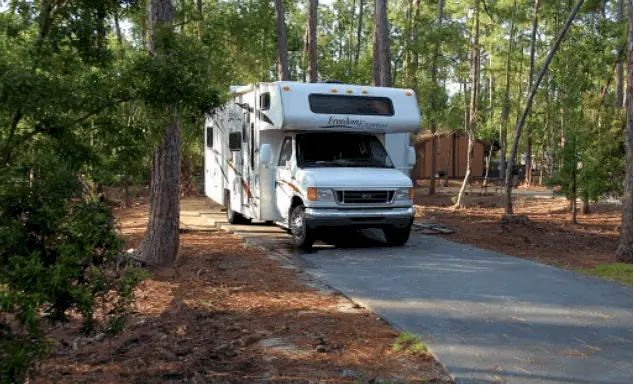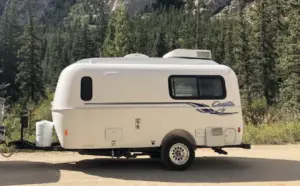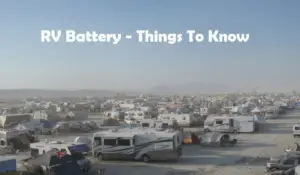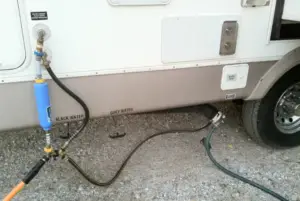A motorhome can be as long as 45 feet long or even more. They accommodate people inside them for proper living and thus, tend to be so much bigger.
Driving a Class c rv or Class A rv can be intimidating for people who have not driven such bigger vehicles much.
Same goes with other RV’s like travel trailer or fifth wheels.
Driving a motorhome can however be stress-free and enjoyable if you follow certain things.
Tips for driving Class C RV
In this article, lets see some of the tips for driving a Class C RV, that is little less in length as compared to Class A Motorhome. (these tips can also be applicable for other RV’s like Class A or Class B motorhome)
Driving class C RV is not hard as long as you get some practice and follow all the rules.
1. Check before you start
A class C rv is big a vehicle, even though it can be much smaller than a full fledged class A motorhome. Even then, it will be good 20 to 30 feet long or even bigger. It can be intimidating to drive such a big vehicle. But, it is not much different than a big regular truck. If you have driven u-haul truck before than this shouldn’t be much different for you.
Best Practice : So, if you are new to class c rv driving or even if you have driven it previously the first thing you should do, is check the surrounding of your rv. Make sure things are clear in and around the motorhome. This is a best practice before driving any kind of motorhome.
Best Routine : It could be parked in front of your home or garage or at a public parking lot, where ever it could be, this should be your first step always. Checking things around the rv gives you confidence and you can either back up or drive straight without a second thought.
Better visualization : Checking the rv this way gives you assurance that you can move it freely and also gives you judgment as to how much you can back up or turn either ways. Remember, once you sit incise the cabin, it may not be possible to visualize better, specially the areas that cant be seen through mirrors.
Among all the motorhomes, Class B are the easiest ones to drive as they are compact and shorter in length. Class C RVs mostly range between 25 to 38 feet long.
2. Get yourself comfortable
Once you are sure of the surrounding of the motorhome, make yourself comfortable in the rv. Adjust the driver seat as per your needs. Do not assume it will comfortable until you really feel it. You, yourselves could have been driving the rv, but still make sure you adjust the seat again; as, when you drive, things do get changed and the seat may not be fully comfortable when you start again.
Air Circulation : Second thing you need to make sure is, the air circulation is happening inside the cabin. Do not turn on the air conditioner immediately. Try keeping the windows open for some time at least.
Windows : Specially, if the motorhome was parked outside in the sun, then its better to keep the windows open for sometime before turning on the cool air from air conditioner. This helps in cooling the vehicle faster and i have seen that, with only ac air; it takes more time to cool the cabin. Once you are comfortable, next thing is to feel the accelerator and brakes with you legs.
3. Take time to do the Basic set up
Buckle yourself up before starting the engine. Make sure it is comfortable for you and neither too fit nor too loose. Rv seat belts are necessary and do not avoid it in any circumstances. In fact, bigger the vehicle, bigger is the impact without seat belts.
Fuel : Next, check the fuel meter. Make sure you have enough fuel for the travel you have planned for. It is always better to refuel at the nearest station rather than waiting till the tank becomes empty.
Headlight : Make sure your headlights are turned on if its night time. Keeping the headlight knob on automatic is good idea, as it automatically turns on the light when it is dark and thus, you are not bothered about turning it “”OFF” and “ON” every time. I myself do it this way, as it reduces one thing to concentrate on while driving such a big vehicle.
Mirrors : Set up rear mirror for good visibility. Check if the backup camera is working or not, do not forget to release handbrake.
By the way, did you know which RV among all types is easy to drive? Its class B.
4. Give passenger safety a high priority
Class C rv can take passengers with them sitting at the back. Unlike travel trailer, where in passengers cannot sit inside the rv. That’s a great thing and you can enjoy the drive sitting as a passenger.
Passengers to minimum, when you are new : If you are new to driving class c rv then try to keep the passengers as minimum as possible. In-fact, do not carry anyone unless you are fully trained driving the rv. Make sure the passengers are properly buckled up with seat belts and no one is standing or moving around.
Communicate : Make sure you have proper communication with each one of them before starting the vehicle. Until and unless each and everyone is seated and comfortable, do not start the motorhome. Ask each one of them to not use any of the appliances while the rv is moving.
5. Practice first drive in parking lot
This tip is for those who have not driven any kind of rv previously. With such big sizes, class c rv aren’t that easy to drive directly on roads specially, if you haven’t done that previously. However confident you may be, just make sure you try driving the class c rv in empty parking lots.
Get judgment right : This will help you in getting the initial judgment. Driving a car is completely a different thing and with 20-30 feet rv, it is going to be little difficult until you judge the length and able to make turns with ease. Driving in open parking lots or space will give you initial confidence and also help you getting to know the vehicle.
Getting used to : Almost all of us have this tendency to over accelerate when we try the vehicle for the first time. It important that you get used to the rv and then only head on traffic lanes.
Class C Motorhomes can be parked on streets as well but be sure to check the local street guidelines as this may not allowed everywhere and not all the time.
6. Take driving classes if not ready
If you feel rving is going to be difficult for you then do not hesitate to take driving classes. Driving a car is different and do not attempt the adventure, if you are not comfortable driving the 30 feet vehicle.
Driving class c motorhome is not difficult but if you don’t have any prior experience with motorhomes or trucks then getting some driving practice will be helpful.
Get the confidence : It is going to be different when making turns and backing up. There are lots of driving schools that will help you in learning the motorhome. Once you learn the driving, try taking the rv yourself. Its good not to try hands until you are confident enough, specially if you have a new rv.
Learn as much as possible : Try to learn all possible things, practice backing up, go on steep hills to see how it feels. Coming down the hill is also one of the major things, as you continuously have to apply brakes. They say a motorhome is for those who learn and enjoy driving and , you need to continuously learn and with experience you should be able to master the skills.
7. Avoid Lane Change
Keeping in your lane and not switching the lanes too often applies to all vehicles. With motorhomes, you need to be more careful though. Do not keep changing lanes unless it is absolutely needed. Do not drive on extreme sides of the lanes.
Keep it in center : Try to keep the motorhome in the center. Also, with bigger road width you wont be going out of lanes. Lanes on roads in US are bigger enough and will be able to accommodate the class c rv easily.
Avoid high speeds : Also, do not over-speed and keep the speed within the posted limits. If you fee to drive little slower than make sure you are driving on the right lanes. On freeway, its always better to go on right lanes, but it depends from person to person. If you are comfortable driving at high speeds then go for it, but never ever cross the speed limit specified.
8. Avoid U turns
Bigger the vehicle bigger is the area needed for the vehicle to make turns. Class c rv, more than 25 feet long will definitely need more space for turning. And, with this kind of length making U turns is going to very difficult and you will need more adjustment to complete the turn.
Try not to U turn : Thus, its better to avoid making such U turns(unless absolutely needed). At least when you are new to driving rv, do not try making U turns unless its very much necessary. With bigger length vehicles you tend to go outside of the road and that may not be advisable to do. Its better to take right or left turns and get to your destination rather than making U turns.
9. Be careful when turning left or right
Making turns with a big motorhome is different as compared to a car or a small truck. You need to go little further than you would in a car, and then turn left or right. A big length of the vehicle makes it necessary to utilizing bigger radius while making the vehicle turn.
Check your speed : Else, you could just get your class c rv’s tires above the curb. You need to get used to this, else you may hit the motorhome to sideways as well. Remember, the speed also need to be reduced substantially. With car, it can be done with little less speed as compared to the straight road, but for a vehicle like class C rv, it is essential that you almost go to zero miles or so before turning.
Be calm and patient : You need not be in hurry while taking the turn, other vehicles behind you should have the idea that the vehicle will take time to turn. And thus, be calm and patient while making the turns. Do not forget to give the side lights and its better to turn ON the side lights little earlier and be prepared for the turn yourself and also indicate others behind you, of your intentions.
10. Keep safe distance between vehicle ahead
When you are driving the motorhome at high speeds make sure you are behind the vehicle in front of with a gap of at-least one similar rv or more. This is necessary because the bigger class c rv will take time to stop when you apply break.
Stopping takes time : This is a normal thing for all other vehicle as well. A bus or bigger truck too, takes good amount of time to stop and thus, this space is needed for the reaction time. Avoid tailgating behind smaller vehicles that may annoy the vehicle owner in front.
Right Lane driving : Make sure you drive at posted speed but keeping in mind the distance you need to maintain between the vehicle in front. Also, driving too slow can be dangerous as the vehicle behind you could get too close to you. If you fee like driving slower, change lanes and be on the right hand side lane. But, in this case you may have to face vehicles that would be existing the way, so you need to be more careful in right lane as well.
11. Do not over-speed
It is not legal to cross the posted speed limit. Always drive at speeds that are allowed. It is okay to go a little above the speed limit but not too high. Like, if the speed limit is 30 mph, going a little above 32 or 33 can still be okay but not 40 mphs for sure.
Uniform acceleration : The speed limits are put for reasons and you cannot exceed those for your own safety and of others too. Going at constant speed gives you sense of control and you will be in better position to stop the motorhome in case needed. Bigger the vehicle, longer is the time taken to come to a complete stop. Do not accelerate unnecessarily, make sure you accelerate at a uniform speed.
12. Use GPS smartly
When moving around in motorhome its always better to plan before moving. Make sure you make use of gps and be prepared about the route. As already discussed, its not a good idea to make U turns and turning also is little difficult with motorhomes, its best to find best way well in time.
Not always the gps shows you best way, so don’t be too dependent on gps too. If you know the route then use your own judgment in finding the route. GPS overall can be a great way to figure out and plan your travel and now a days, everybody is so much dependent on the online map routes.
13. Practice parking
Parking a rv is another challenge but with practice you should be able to master that too. One of the important things with parking is ability to judge the space. Not all parking slots will be accommodating the large class c rv and thus you may end up utilizing 2 or more slots for parking.
Take help from passengers: At campground you would be able to get full parking slot. While parking, you need to judge the space correctly and park with care. It is better if someone with you can get down and help you while you move the motorhome in the slot. A backing camera is also of great help during parking.
Get a backing up camera : But, not all class c rv’s will have backing camera and thus, be prepared to do it without a camera. If you have a class c rv that wasn’t equipped with a backup camera than try to get one for your motorhome. Such a camera is of great help when you are alone, and nobody is with you in the motorhome.
14. Be extra careful while backing up
Backing up a class c rv is challenging, in-fact this is the case with any kind of rv. Its mostly because of the height and the length of the vehicle. A 20 to 30 feet length of vehicle definitely needs great judgment, a camera for backing up helps a lot. But, you should be prepared to do it without camera.
You never know when the luxury of camera may not work for you. Even when driving tests are done, dmv does not allow to use the camera. Idea is to be self sufficient and not dependent on the luxury of a backing up camera. You need to position yourself in such a way so that you can see at the back, and be sure that nobody is at the backside of the rv.





